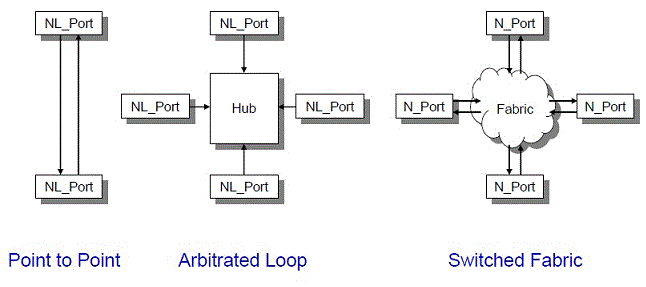
Point-to-Point: In this topology, devices are connected directly to each other. This topology allows the devices to communicate using the full bandwidth of the link.
Arbitrated Loop (FC-AL): In this topology, devices are attached to a shared “loop”. FC-AL is analogous to the token ring topology. Each device has to contend for performing I/O on the loop by a process called “arbitration” and, at any given time, only one device can “own” the I/O on the loop. This results in a shared bandwidth environment. Private Arbitrated loops restrict the number of devices to 126 (plus the initiator).
Each device has a unique id called ALPA (Arbitrated Loop Physical Address) by which it is identified on the loop. In a loop environment, each time the topology changes (i.e. when devices are added or removed) the loop has to be re-initialized by a process known as a LIP (Loop initialization protocol) reset. This results in a momentary pause in I/O. It is for this reason that arbitrated loop environments don’t scale well and are limited to a few devices only. Most implementations of arbitrated loop provide a star topology to a loop by implementing a device called a hub. Hubs have won wide acceptance in JBOD (Just a Bunch of Disks) environments, because just as JBOD costs less than enterprise storage, hubs cost less than switches.
Switched Fabric (FC-SW): In this topology, each device has a unique dedicated I/O path to another device. This is accomplished by implementing a device known as a fabric switch. A fabric switch is analogous to an IP switch. When a device is physically connected to a switch port, it establishes a point-to-point connection with the port and logs into the fabric by a process called a fabric logon (defined in the FC2 layer) and registers itself with the fabric name server, which is a virtual database to keep track of devices connected to the switch. Thus in essence, it establishes a point-to-point connection with a port on the switch. It then sends a request to access another device which is connected to the same switch. In most cases, this is either a storage array or a tape drive. Once this request is granted, the switch makes a note of this connection and a dedicated path is established. This path is now totally independent of any topology changes to the switch (i.e. devices being
added or removed) and results in dedicated bandwidth. Switched fabric environments use a 24-bit addressing scheme to identify devices and hence can accommodate up to 15 million devices. The reason why switched fabric provides higher performance than arbitrated loop is because a switch based fabric provides full bandwidth between the nodes in the fabric. At any given time there can be n/2 full bandwidth connections between nodes in the fabric (one connection for the initiator and one connection for the target).